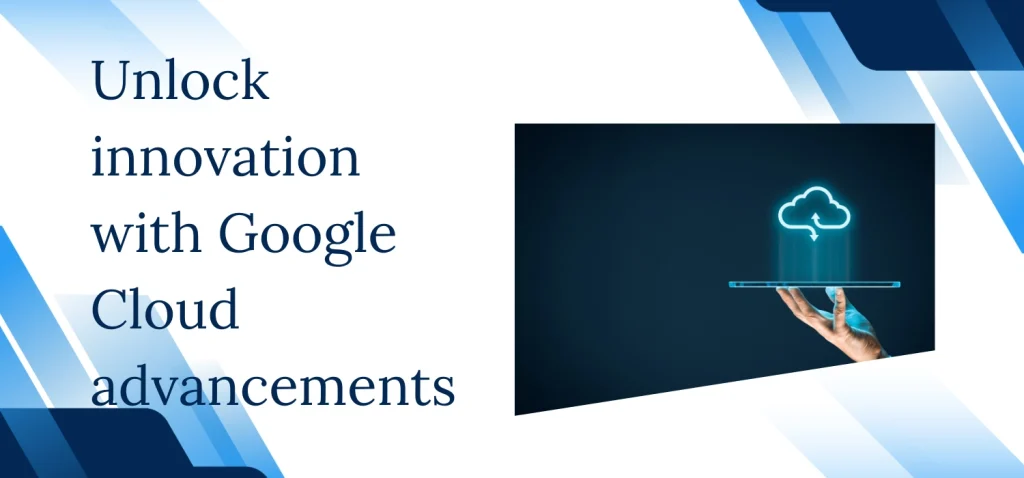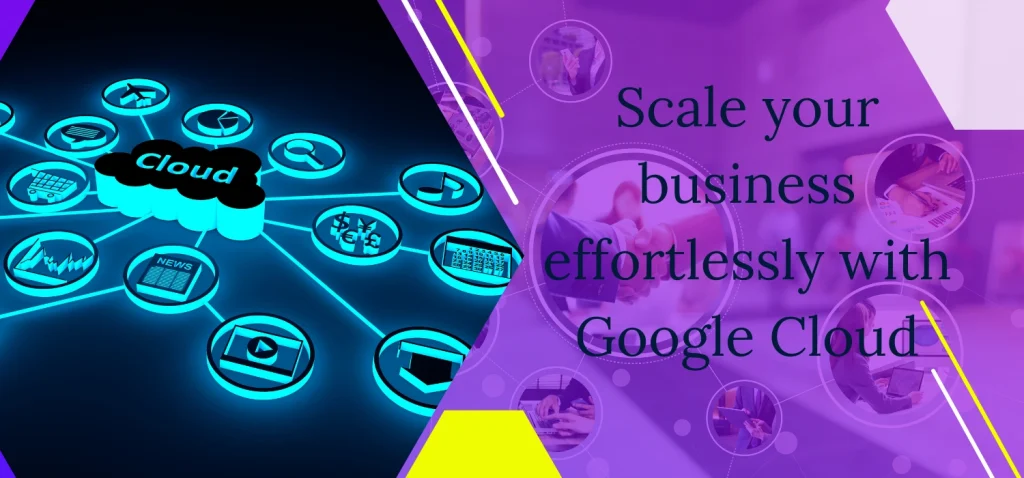
Have you ever wondered where all your photos, videos, and even some of your apps are stored? That’s right—it’s in the cloud! But what exactly is cloud computing, and why is it so important for our future? Today, we’re diving deep into the world of cloud computing with Google Cloud. We’ll explore how it works, why it’s essential for businesses and individuals, and what the future holds.
Our goal is to make this information easy to understand and engaging, so whether you’re a tech newbie or a seasoned pro, you’ll find something valuable here. Let’s get started!
What is Cloud Computing?
Before we talk about the future, let’s make sure we all understand what cloud computing is. Imagine you have a library full of books, but instead of keeping all those books in your house, you store them in a huge, super-secure warehouse. Whenever you need a book, you can access it from the warehouse instantly, from anywhere. That’s essentially what cloud computing is—storing and accessing data and applications over the internet instead of on your computer’s hard drive.
Google Cloud is one of the major players in this field, providing all kinds of services like storage, databases, machine learning, and even tools to build apps.
Why is Cloud Computing Important?
Cloud computing has changed the way we use technology in several significant ways:
- Accessibility: You can access your data and applications from anywhere in the world, as long as you have an internet connection.
- Cost-Effective: Instead of buying expensive hardware, you can use the cloud, which offers flexible pricing models.
- Scalability: Need more storage or computing power? With the cloud, you can scale up or down as needed without investing in new hardware.
- Security: Major cloud providers like Google Cloud offer top-notch security features to protect your data.
Now that we know the basics, let’s dive into the future of cloud computing with Google Cloud.
The Future of Cloud Computing with Google Cloud

1. Advanced Artificial Intelligence and Machine Learning
One of the most exciting aspects of Google Cloud is its powerful AI and machine learning capabilities. In the future, these technologies will become even more integrated and user-friendly. Imagine a world where businesses can use AI to predict customer behavior, automate tasks, and even create personalized shopping experiences—all powered by Google Cloud’s AI tools.
For example, Google Cloud’s AutoML allows developers with limited machine learning expertise to train high-quality models specific to their needs. This means that even small businesses can leverage AI to gain insights and improve their operations.
2. Quantum Computing
Quantum computing is another frontier that Google Cloud is exploring. Quantum computers use quantum bits, or qubits, which can perform complex calculations much faster than traditional computers. Google has already made significant strides in this area with its quantum processor, Sycamore, achieving “quantum supremacy.”
In the future, quantum computing could revolutionize industries like pharmaceuticals, finance, and cryptography by solving problems that are currently impossible for classical computers. Google Cloud will likely play a pivotal role in making quantum computing accessible to businesses worldwide.
3. Serverless Computing
Serverless computing is a cloud computing model where the cloud provider automatically manages the infrastructure, allowing developers to focus solely on writing code. Google Cloud’s serverless offerings, such as Cloud Functions and Cloud Run, make it easy for developers to build and deploy applications without worrying about the underlying infrastructure.
As this technology evolves, we can expect even more streamlined and efficient development processes. Businesses will be able to launch new applications faster, scale them automatically, and reduce costs by only paying for what they use.
4. Enhanced Security and Privacy
Security is always a top concern when it comes to cloud computing. Google Cloud is continuously improving its security measures to protect data from threats. In the future, we can expect even more advanced security features, such as:
- Zero Trust Security: A security model that requires strict verification for every user and device trying to access resources, ensuring that no one is trusted by default.
- Confidential Computing: A technology that encrypts data while it is being processed, providing an additional layer of security.
- AI-Powered Threat Detection: Using artificial intelligence to detect and respond to threats in real-time, minimizing potential damage.
5. Sustainable Cloud Computing
As the world becomes more aware of environmental issues, sustainability in cloud computing will become increasingly important. Google Cloud is already a leader in this area, being the first major cloud provider to commit to running on carbon-free energy by 2030.
In the future, we can expect more innovations aimed at reducing the environmental impact of cloud computing. This could include more efficient data centers, better resource management, and increased use of renewable energy sources.
6. Integration with Edge Computing
Edge computing involves processing data closer to where it is generated, rather than in a centralized cloud location. This reduces latency and bandwidth usage, making it ideal for applications that require real-time processing, such as IoT (Internet of Things) devices and autonomous vehicles.
Google Cloud is already working on integrating edge computing with its cloud services. In the future, this will enable businesses to leverage the power of both edge and cloud computing, creating more responsive and efficient applications.
How Google Cloud Can Help Your Business
Now that we’ve explored the future of cloud computing with Google Cloud, let’s talk about how it can help your business today.
1. Cost Savings
One of the biggest advantages of using Google Cloud is cost savings. Instead of investing in expensive hardware and maintaining it, you can use Google Cloud’s pay-as-you-go model. This means you only pay for the resources you use, making it more cost-effective, especially for small and medium-sized businesses.
2. Scalability
Whether you’re running a small blog or a large e-commerce platform, Google Cloud can scale with your needs. If you experience a sudden surge in traffic, Google Cloud can automatically allocate more resources to handle the load. Once the traffic decreases, it scales down, saving you money.
3. Improved Collaboration
Google Cloud offers a suite of productivity tools, such as Google Workspace (formerly G Suite), that allows your team to collaborate seamlessly. With tools like Google Docs, Sheets, and Drive, your team can work together in real-time, regardless of their location.
4. Enhanced Security
Google Cloud provides robust security features to protect your data. With features like encryption, identity and access management, and regular security updates, you can have peace of mind knowing your data is safe.
5. Innovation and Competitive Advantage
By leveraging Google Cloud’s advanced technologies, such as AI and machine learning, you can gain insights into your business, automate tasks, and create personalized experiences for your customers. This can give you a competitive advantage and drive growth.
Getting Started with Google Cloud
Ready to dive into the world of Google Cloud? Here’s a step-by-step guide to get you started:
1. Sign Up for a Google Cloud Account
The first step is to sign up for a Google Cloud account. Google offers a free tier that provides you with some resources to get started without any cost.
2. Explore the Console
Once you have your account, log in to the Google Cloud Console. This is where you’ll manage all your cloud resources. Take some time to explore the interface and familiarize yourself with the various services and tools available.
3. Create a Project
In Google Cloud, everything is organized into projects. Create a new project for your business. This will help you manage resources, set permissions, and keep everything organized.
4. Choose Your Services
Depending on your needs, you can choose from a wide range of services offered by Google Cloud. Some popular services include:
- Compute Engine: For virtual machines and infrastructure.
- App Engine: For building and deploying applications.
- Cloud Storage: For storing and retrieving data.
- BigQuery: For data analytics and insights.
- AI and Machine Learning: For building intelligent applications.
5. Set Up Billing
To start using Google Cloud services, you’ll need to set up billing. Google Cloud offers a pay-as-you-go model, so you’ll only pay for the resources you use. Be sure to set up billing alerts to monitor your usage and avoid unexpected charges.
6. Start Building
With everything set up, you can start building your applications and services on Google Cloud. Use the documentation and tutorials provided by Google to learn how to use the various tools and services.
7. Monitor and Optimize
Once your applications are up and running, use Google Cloud’s monitoring tools to keep an eye on performance and resource usage. Optimize your resources to ensure you’re getting the best performance and cost-efficiency.
Real-World Examples
To give you a better idea of how businesses are using Google Cloud, let’s look at some real-world examples:
1. Spotify
Spotify, the popular music streaming service, uses Google Cloud to deliver music to millions of users worldwide. By leveraging Google Cloud’s global infrastructure, Spotify can provide a seamless and reliable streaming experience.
2. Snap Inc.
Snap Inc., the company behind Snapchat, uses Google Cloud to handle its massive data storage and processing needs. Google Cloud’s scalability and performance allow Snapchat to deliver fast and engaging experiences to its users.
3. The New York Times
The New York Times uses Google Cloud for data analytics and machine learning. By analyzing reader behavior and preferences, they can deliver personalized content and improve user engagement.
4. HSBC
HSBC, one of the world’s largest banking and financial services organizations, uses Google Cloud to enhance its data analytics capabilities. This allows them to gain insights into customer behavior, improve risk management, and drive innovation.
Best Practices for Using Google Cloud
To make the most of Google Cloud, here are some best practices to keep in mind:
1. Understand Your Requirements
Before diving into Google Cloud, clearly define your requirements. Understand what you need in terms of computing power, storage, security, and other resources.
2. Use the Right Tools
Google Cloud offers a wide range of tools and services. Choose the ones that best meet your needs. For example, use BigQuery for data analytics, Cloud Storage for data storage, and AI tools for machine learning.
3. Monitor Usage
Regularly monitor your resource usage to ensure you’re not overpaying for unused resources. Use Google Cloud’s monitoring tools to keep track of performance and optimize your usage.
4. Implement Security Best Practices
Security should always be a top priority. Implement security best practices, such as using strong passwords, enabling two-factor authentication, and regularly updating your software.
5. Stay Updated
Google Cloud is continuously evolving, with new features and services being added regularly. Stay updated with the latest developments and take advantage of new tools and technologies to improve your operations.
Conclusion
The future of cloud computing with Google Cloud is bright and full of possibilities. From advanced AI and quantum computing to serverless computing and enhanced security, Google Cloud is at the forefront of innovation.
By leveraging Google Cloud, businesses can reduce costs, improve scalability, enhance security, and drive innovation. Whether you’re a small startup or a large enterprise, Google Cloud offers the tools and services you need to succeed.
So, what are you waiting for? Dive into the world of Google Cloud and unlock the potential of your business. The future is in the cloud, and it’s time to embrace it.
Remember, the key to success is continuous learning and adaptation. Stay curious, stay informed, and keep exploring the amazing possibilities that Google Cloud offers.



